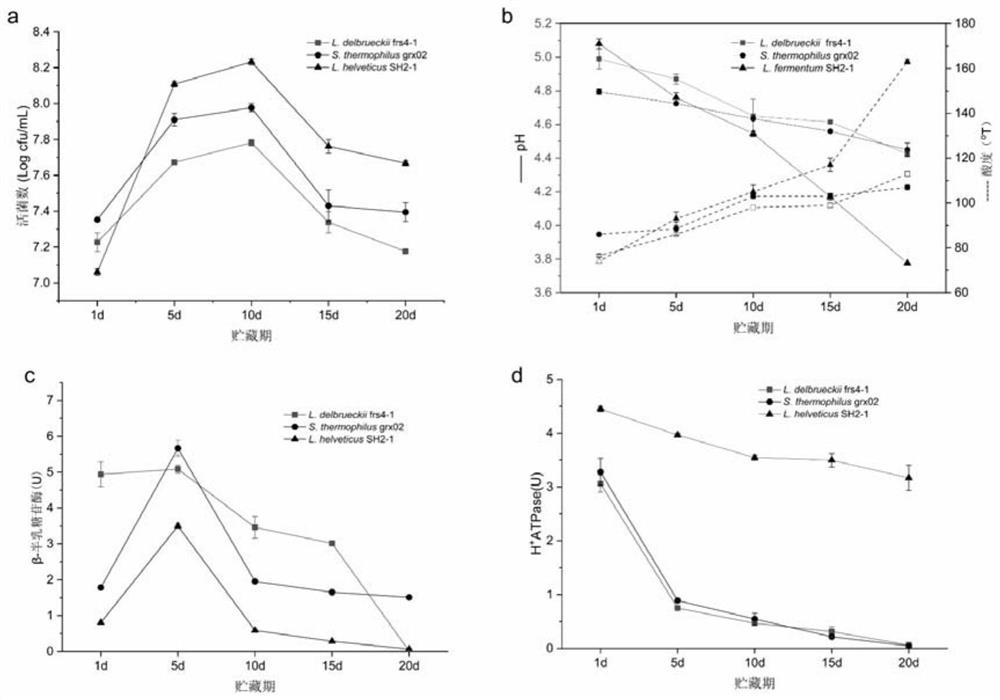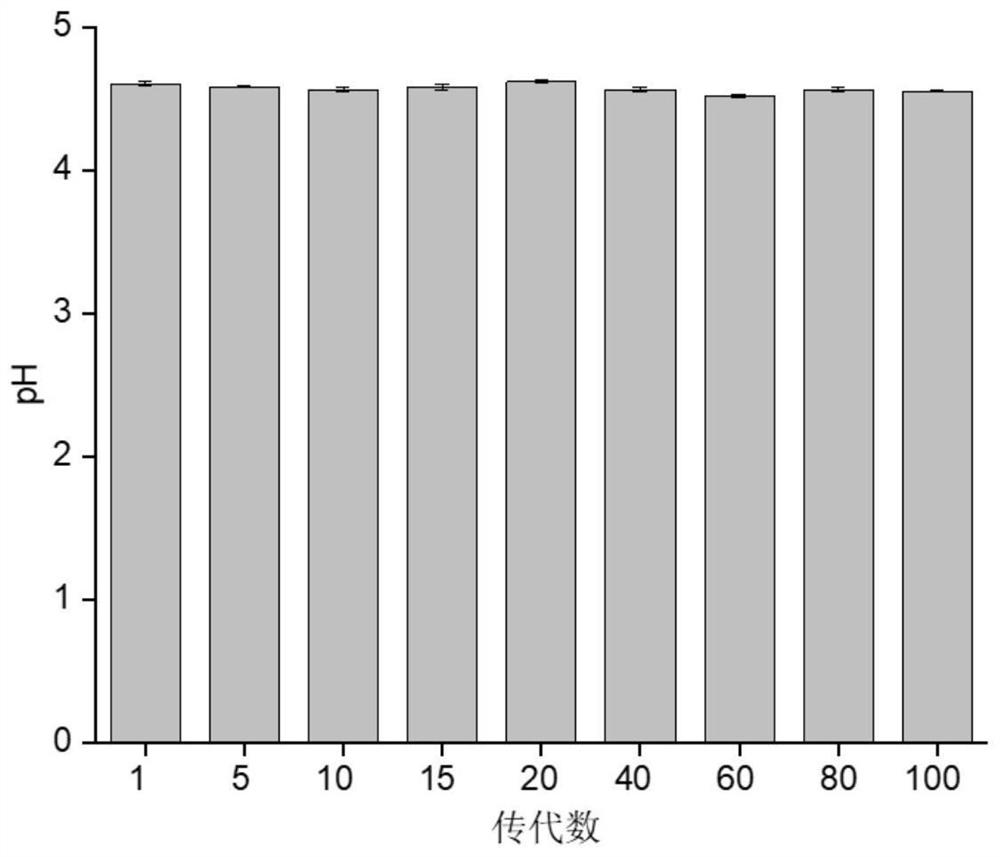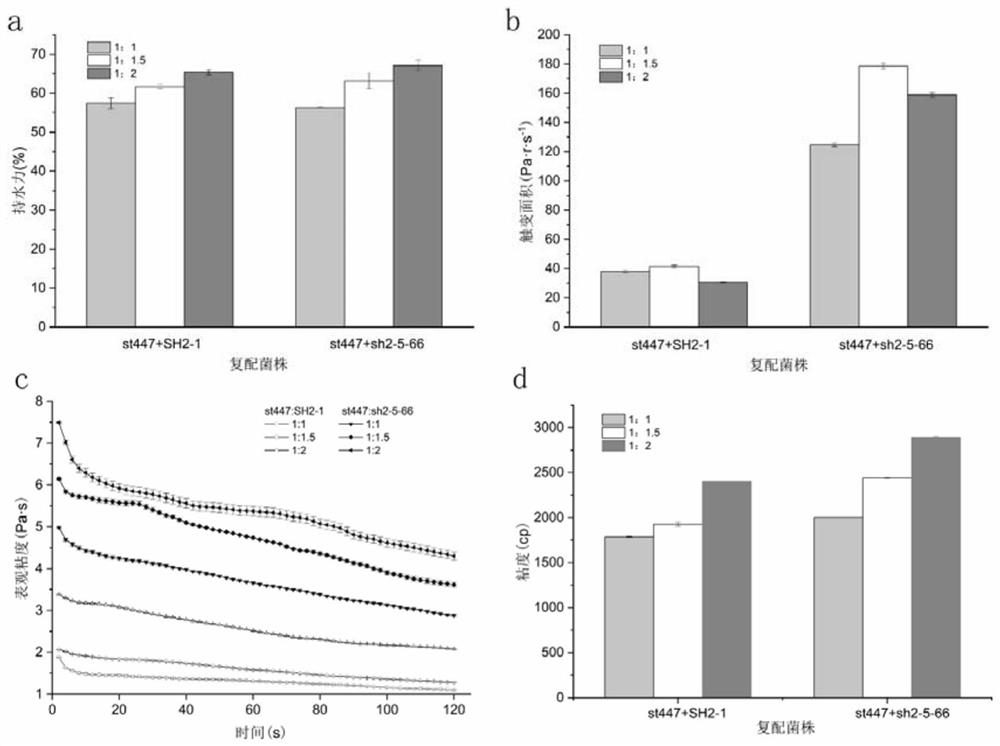Weakly post-acidified Lactobacillus helveticus sh2-5-66 and its application
A post-acidification, lactobacillus technology, applied in the field of lactic acid bacteria, can solve the problems of complicated operation, retention of lactic acid bacteria, unstable genetic properties and other problems
- Summary
- Abstract
- Description
- Claims
- Application Information
AI Technical Summary
Problems solved by technology
Method used
Image
Examples
preparation example Construction
[0059] (1) Preparation of Fermented Milk Crude Enzyme Liquid
[0060] Take 10.0 g of fermented milk for the 1st, 5th, 10th, 15th, and 20th day of storage, remove the protein with 1% EDTA solution (pH=12, 4°C) and resuspend in TE buffer, add lysozyme, and bathe in 37°C for 1 hour. Centrifuge to remove the supernatant, resuspend with normal saline, and crush the cell suspension with a high-pressure cytometer to extract the crude enzyme solution for the determination of β-galactosidase and H + - ATPase enzyme activity.
[0061] (2) Determination of β-galactosidase activity
[0062] (a) draw ONP (o-nitrophenol) standard curve
[0063] (b) β-galactosidase activity assay
[0064] Take 1mL of crude enzyme solution, put it in a water bath at 37°C for 10min, add 1mL of ONPG solution (pH 7.0, 20mmol / L), react at 37°C for 10min, and immediately add 3mL of 0.5mol / L Na 2 CO 3 The solution terminated the reaction, and the absorbance was measured at 420 nm. .
[0065] β-galactosidase ...
Embodiment 1
[0082] Mutation Breeding, Screening and Identification of Weak Postacidification Strains
[0083] 1. Mutation breeding
[0084] Using a 20W ultraviolet lamp, the irradiation distance was 30cm, and the irradiation distance was 0s, 30s, 60s, 90s, and 120s respectively, and the lethal rate under the mutagenesis time was determined (Table 1). The lethality rate of the strain was over 80% after irradiating for 50s, so the time of mutagenic irradiation was set at 50s-60s.
[0085] Table 1 Effect of mutagenesis time on the lethality of L.helveticus SH2-1
[0086]
[0087] 2. Screening
[0088] (1) Establishment of post-acidification screening indicators
[0089] In order to determine the screening index of the enzyme coupled with post-acidification of Lactobacillus helveticus SH2-1 for the screening of late-stage mutagenesis strains, this part of the experiment measured the storage period index of L. helveticus SH2-1 after fermentation, and selected two strains with weak post-a...
Embodiment 2
[0102] (1) Fermentation effect experiment of L.helveticus sh2-5-66
[0103] Ferment SH2-1 (L. helveticus SH2-1) and sh2-5-66 (L. helveticus sh2-5-66) in a single strain, or mix it with commercial starter st447 (S. thermophilus st447) in different proportions Mixed bacteria fermentation, determination of the quality index of fermented milk, the specific experimental method is as follows:
[0104] Single-bacteria fermentation: Inoculate the activated strain into the prepared skim milk medium according to the amount of 3%, place it in a constant temperature incubator at 42°C for cultivation, observe the curdling situation, record the curdling time, and place it in a refrigerator at 4°C storage.
[0105] Mixed bacteria fermentation: compound st447 with Lactobacillus helveticus SH2-1 and sh2-5-66 before and after mutagenesis according to the ratio of 1:1, 1.5:1, and 2:1, and the total number of viable bacteria added is 6 ×10 6 cfu / mL for inoculation and fermentation, placed in a...
PUM
 Login to View More
Login to View More Abstract
Description
Claims
Application Information
 Login to View More
Login to View More - R&D
- Intellectual Property
- Life Sciences
- Materials
- Tech Scout
- Unparalleled Data Quality
- Higher Quality Content
- 60% Fewer Hallucinations
Browse by: Latest US Patents, China's latest patents, Technical Efficacy Thesaurus, Application Domain, Technology Topic, Popular Technical Reports.
© 2025 PatSnap. All rights reserved.Legal|Privacy policy|Modern Slavery Act Transparency Statement|Sitemap|About US| Contact US: help@patsnap.com



